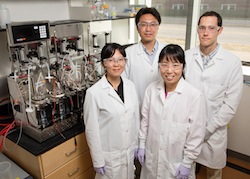 A hat tip to my friend Jessica Robinson over at the National Biodiesel Board for pointing out this great article from Biofuels Digest. As the U.S. Environmental Protection Agency (EPA) has proposed lower targets for the 2014 Renewable Fuel Standard, proponents of biodiesel are wondering why their green fuel is targeted a 20 percent reduction.
A hat tip to my friend Jessica Robinson over at the National Biodiesel Board for pointing out this great article from Biofuels Digest. As the U.S. Environmental Protection Agency (EPA) has proposed lower targets for the 2014 Renewable Fuel Standard, proponents of biodiesel are wondering why their green fuel is targeted a 20 percent reduction.
Let’s review the background on biodiesel and renewable diesel. There’s no blend wall in sight, production volumes have been growing fast, prices have been relatively stable, and because it provides a market for soybean oil, it reduces prices for ranchers and poultry farmers who use the soybean meal as animal feed.
Here are answers to your questions regarding biomass-based diesel and the proposed 2014 and 2015 standards.
Q: What is EPA’s stated method and target?
A: In the draft EPA document that is floating around the industry — which the Digest has reviewed — the EPA writes that it aims to “Base advanced volume on availability of advanced biofuels but considering the blendwall” by [setting} the advanced volume at the sum of the cellulosic standard, the BBD standard and all available volumes of non-ethanol advanced.” EPA adds that it intends to “Maintain biomass-based diesel std at 1.28 Bgal; since BBD is nested within the advanced biofuel standard, any excess volumes above 1.28 bill gal can compete with other advanced biofuels. There is limited availability of other advanced biofuels, which generates opportunities for biodiesel production above 1.28 bill gal to help meet the advanced biofuel standard.”Read More









